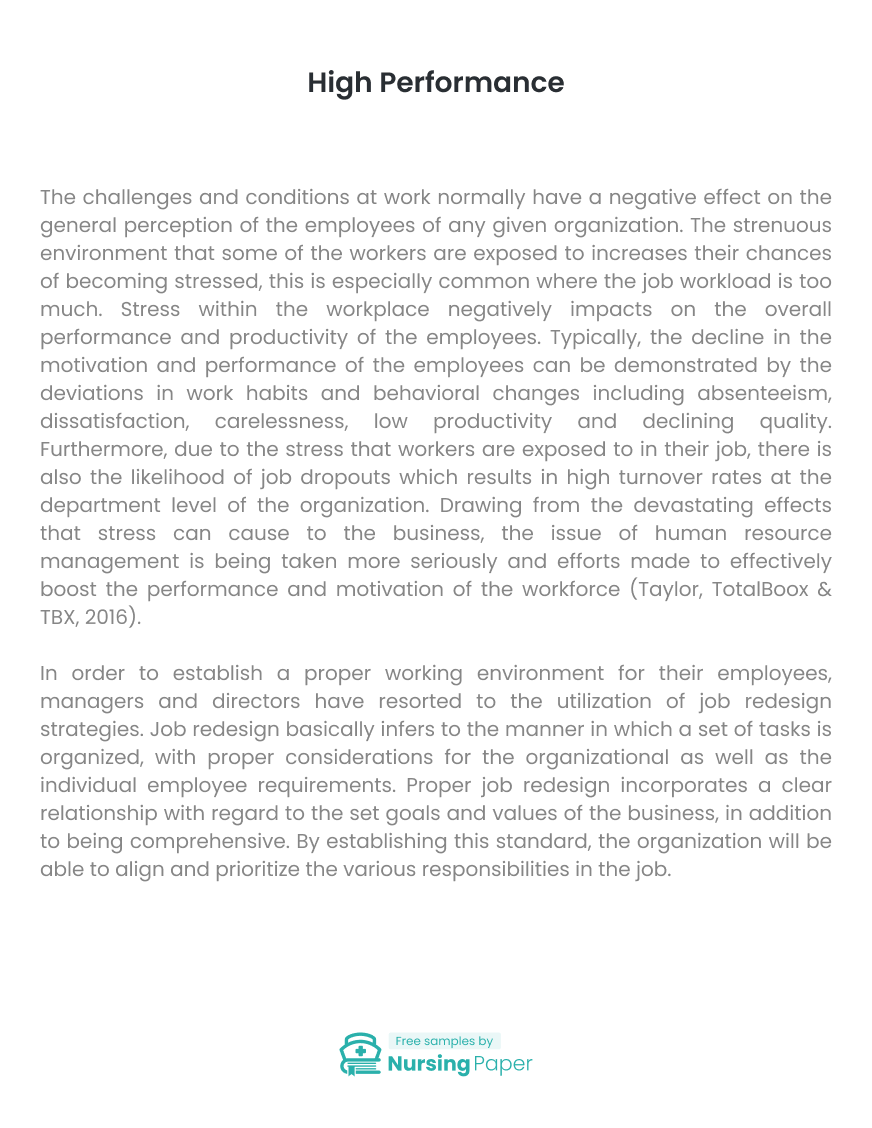
High Performance
Introduction
The challenges and conditions at work normally have a negative effect on the general perception of the employees of any given organization. The strenuous environment that some of the workers are exposed to increases their chances of becoming stressed, this is especially common where the job workload is too much. Stress within the workplace negatively impacts on the overall performance and productivity of the employees. Typically, the decline in the motivation and performance of the employees can be demonstrated by the deviations in work habits and behavioral changes including absenteeism, dissatisfaction, carelessness, low productivity and declining quality. Furthermore, due to the stress that workers are exposed to in their job, there is also the likelihood of job dropouts which results in high turnover rates at the department level of the organization. Drawing from the devastating effects that stress can cause to the business, the issue of human resource management is being taken more seriously and efforts made to effectively boost the performance and motivation of the workforce (Taylor, TotalBoox & TBX, 2016).
In order to establish a proper working environment for their employees, managers and directors have resorted to the utilization of job redesign strategies. Job redesign basically infers to the manner in which a set of tasks is organized, with proper considerations for the organizational as well as the individual employee requirements. Proper job redesign incorporates a clear relationship with regard to the set goals and values of the business, in addition to being comprehensive. By establishing this standard, the organization will be able to align and prioritize the various responsibilities in the job. Thus, in order to amicably fulfill these objectives, job redesigning should be able to allow for employee input by providing for options to vary tasks with the prevailing workplace environment; integrate employee training in the job so that they become more aware of the demands and how to do their job, and; offer proper work-rest schedule, and cater for adjustments especially in physical jobs (Goh et al. 2015).


The identified measures for the improvement of working environment for an improved output of the employees can be established through three major job redesigning strategies, including job enlargement, job enrichment, and job rotation (Dwivedula, Bredillet & Muller, 2015). Job enlargement allows for the horizontal job expansion, hence increases the scope and diversity of tasks an employee performs. This strategy decreases the level of boredom that may arise from a fixed task. Secondly, job rotation involves the shuffling of employees in pre-determined jobs, this is beneficial in the acquisition of new knowledge and skills, especially for those who seek for job advancement. And, finally, job enrichment increases the depth of the job, providing the employee with more authority to make decisions in their position. This mechanism is a motivational tool which enhances the skills of the managers to make decisions.
Conclusion
In summary, job design can be seen as a continuous and ever-changing process, which primarily purposes to assist employees of a given organization in making proper and necessary adjustments in relation to the dynamic nature of their places of work. By adequately redesigning the job, the managers and directors of an organization will be able to achieve the end goal of a reduction in the level of dissatisfaction, thereby boosting motivation as well as employee engagement in the job, contributing to improved performances.
1. Dwivedula, R., Bredillet, C., & Muller, R. (2015). Towards Understanding of Work Motivation in Temporary Organizations. PM World Journal, 4(9), 1-12.
2. Goh, J., Pfeffer, J., Zenios, S. A., & Rajpal, S. (2015). Workplace stressors & health outcomes: Health policy for the workplace. Behavioral Science & Policy, 1(1), 43-52.
3. Taylor, F. W., TotalBoox & TBX. (2016). The Principles of Scientific Management. Cosimo Classics.



The download will start shortly.

The download will start shortly.
 Subject:
Nursing
Subject:
Nursing  Number of pages: 5
Number of pages: 5  Subject:
Nursing
Subject:
Nursing  Number of pages: 5
Number of pages: 5  Subject:
Medicine
Subject:
Medicine  Number of pages: 5
Number of pages: 5  Subject:
Medicine
Subject:
Medicine  Number of pages: 3
Number of pages: 3  Subject:
Nursing
Subject:
Nursing  Number of pages: 11
Number of pages: 11  Subject:
Nursing
Subject:
Nursing  Number of pages: 4
Number of pages: 4  Subject:
Nursing
Subject:
Nursing  Number of pages: 5
Number of pages: 5  Subject:
Nursing
Subject:
Nursing  Number of pages: 8
Number of pages: 8  Subject:
Nursing
Subject:
Nursing  Number of pages: 8
Number of pages: 8  Subject:
Health and Social Care
Subject:
Health and Social Care  Number of pages: 2
Number of pages: 2  Subject:
Health and Social Care
Subject:
Health and Social Care  Number of pages: 2
Number of pages: 2  Subject:
Nursing
Subject:
Nursing  Number of pages: 1
Number of pages: 1  Subject:
Medicine
Subject:
Medicine  Number of pages: 5
Number of pages: 5  Subject:
Health and Social Care
Subject:
Health and Social Care  Number of pages: 2
Number of pages: 2  Subject:
Medicine
Subject:
Medicine  Number of pages: 3
Number of pages: 3 
